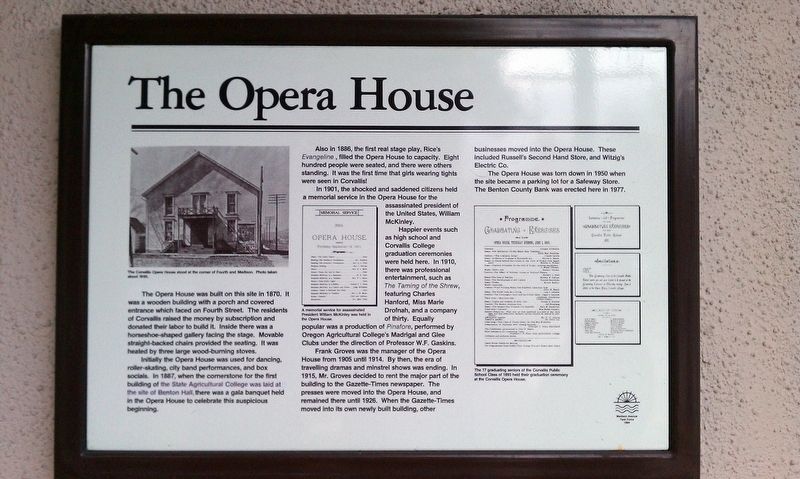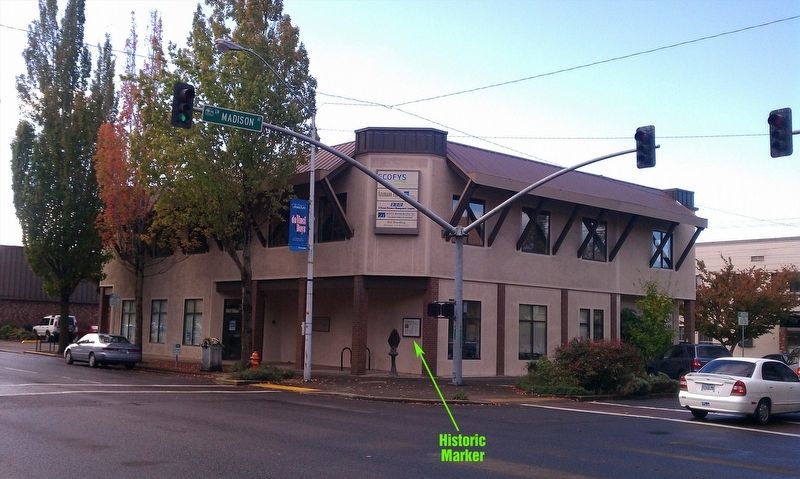Corvallis in Benton County, Oregon — The American West (Northwest)
The Opera House
Initially, the Opera House was used for dancing, roller-skating, city band performances, and box socials. In 1887, when the cornerstone for the first building of the State Agricultural College was laid at the site of Benton Hall, there was a gala banquet held in the Opera House to celebrate this auspicious beginning.
Also in 1886, the first real stage play, Rice's Evangeline, filled the Opera House to capacity. Eight hundred people were seated, and there were others standing. It was the first time that girls wearing tights were seen in Corvallis!
In 1901, the shocked and saddened citizens held a memorial service in the Opera House for the assassinated president of the United States, William McKinley.
Happier events such as high school and Corvallis College graduation ceremonies were held here. In 1910, there was professional entertainment, such as the The Taming of the Shrew, featuring Charles Hanford, Miss Marie Drofnah, and a company of thirty. Equally popular was a production of Pinafore, performed by Oregon Agricultural College's Madrigal and Glee Clubs under the direction of Professor W.F. Gaskins.
Frank Groves was the manager of the Opera House from 1905 until 1914. By then, the era of travelling dramas and minstrel shows was ending. In 1915, Mr. Groves decided to rent the major part of the building to the Gazette-Times newspaper. The pressed were moved into the Opera House, and remained there until 1926. When the Gazette-Times moved into its own built building, other businesses moved into the Opera House. These included Russell's Second Hand Store, and Witzig's Electric Co.
The Opera House was torn down in 1950 when the site became a parking lot for a Safeway Store. The Benton County Bank was erected here in 1977.
Erected 1984 by Madison Avenue Task Force.
Topics and series. This historical marker is listed in this topic list: Notable Buildings. In addition, it is included in the Former U.S. Presidents: #25 William McKinley series list. A significant historical year for this entry is 1870.
Location. 44° 33.813′ N, 123° 15.76′ W. Marker is in Corvallis, Oregon, in Benton County. Marker is at the intersection of Pacific Highway West and Pacific Hwy W (U.S. 20) on Pacific Highway West. Touch for map. Marker is in this post office area: Corvallis OR 97333, United States of America. Touch for directions.
Other nearby markers. At least 8 other markers are within walking distance of this marker. The Whiteside Theatre (a few steps from this marker); City Hall (within shouting distance of this marker); L.G. Kline Building (about 500 feet away, measured in a direct line); Benton County Courthouse (about 500 feet away); Benton County State Bank (about 700 feet away); Site of Corvallis Public Schools (approx. 0.2 miles away); Madison Avenue (approx. 0.2 miles away); The Corvallis Arts Center (approx. 0.2 miles away). Touch for a list and map of all markers in Corvallis.
More about this marker. This historical marker was placed in 2004 by the Madison Avenue Task Force. It is comprised of a volunteer group of citizens whose mission is to provide a walking tour of downtown Corvallis for pedestrians to pause and appreciate Corvallis' history and art. Many historical markers and art objects are strategically placed throughout the walking tour.
Credits. This page was last revised on January 20, 2018. It was originally submitted on January 18, 2018, by Douglass Halvorsen of Klamath Falls, Oregon. This page has been viewed 198 times since then and 9 times this year. Photos: 1, 2. submitted on January 18, 2018, by Douglass Halvorsen of Klamath Falls, Oregon. • Bill Pfingsten was the editor who published this page.

